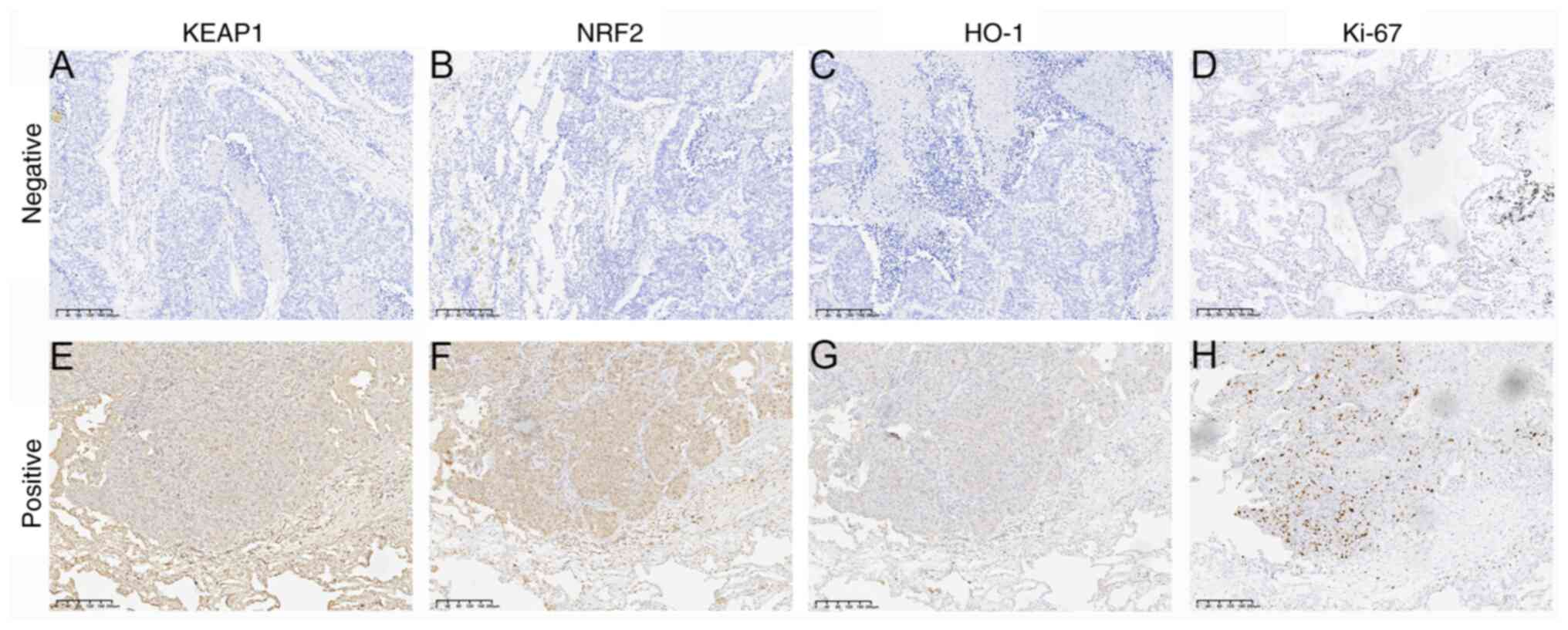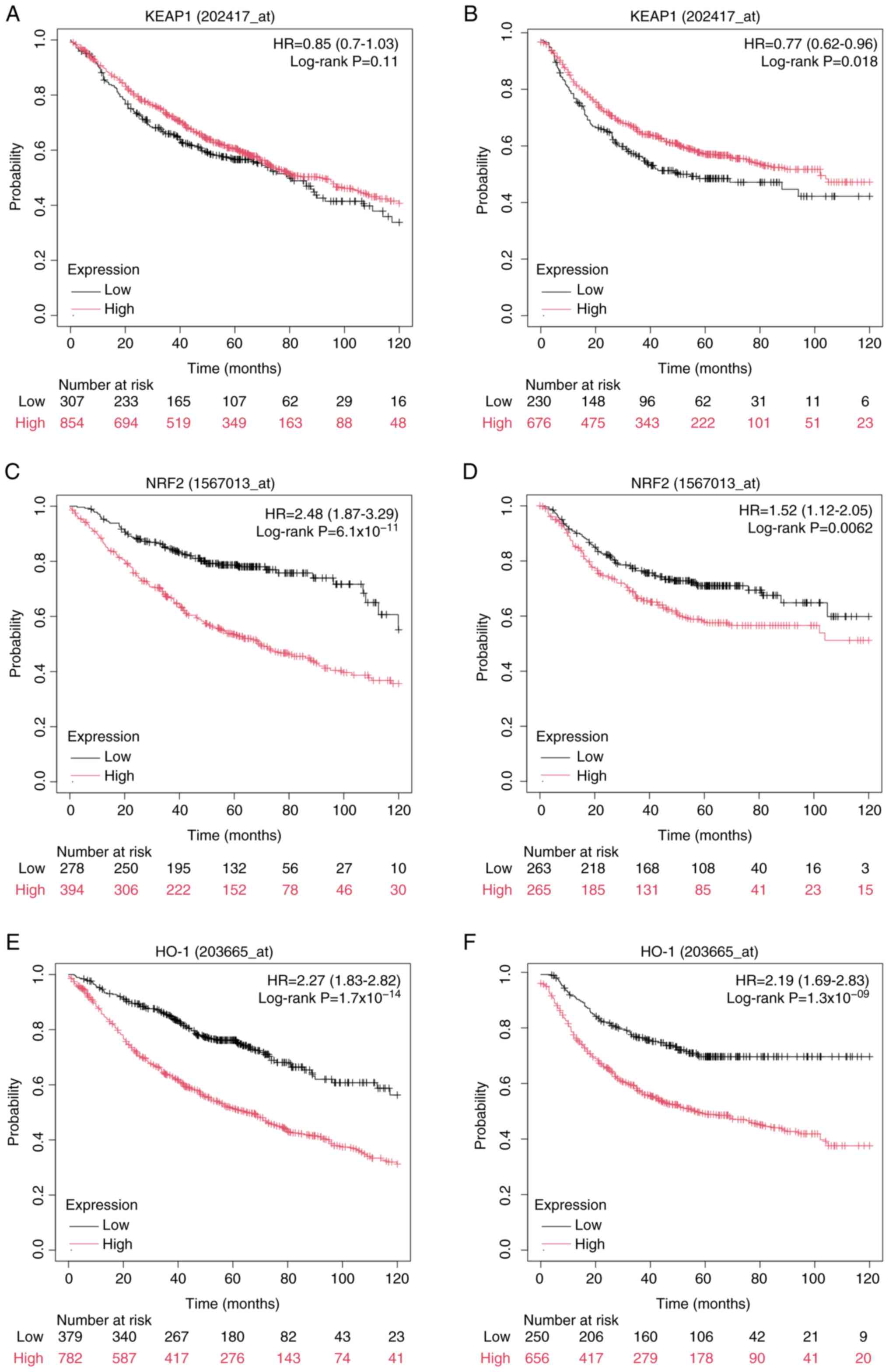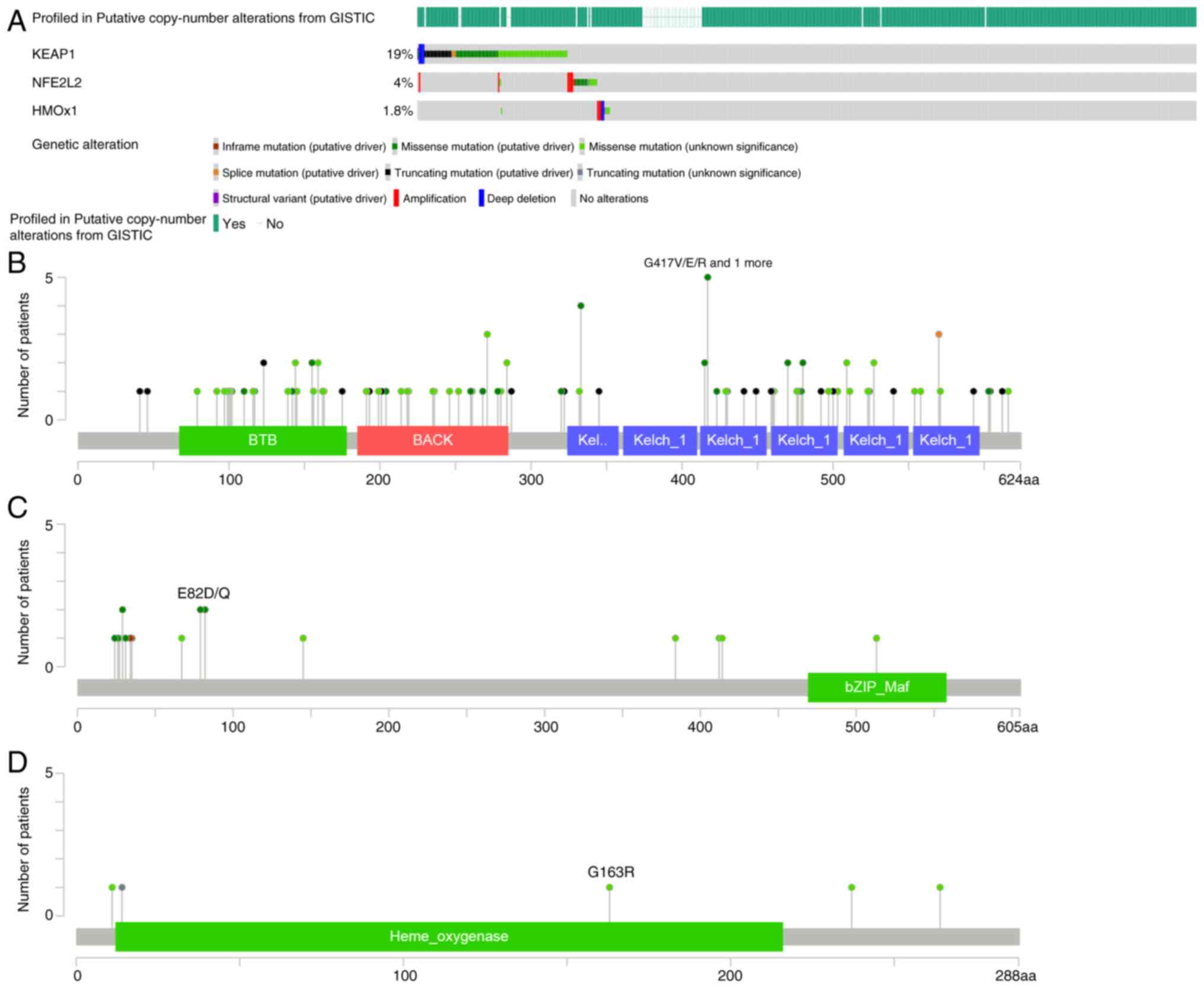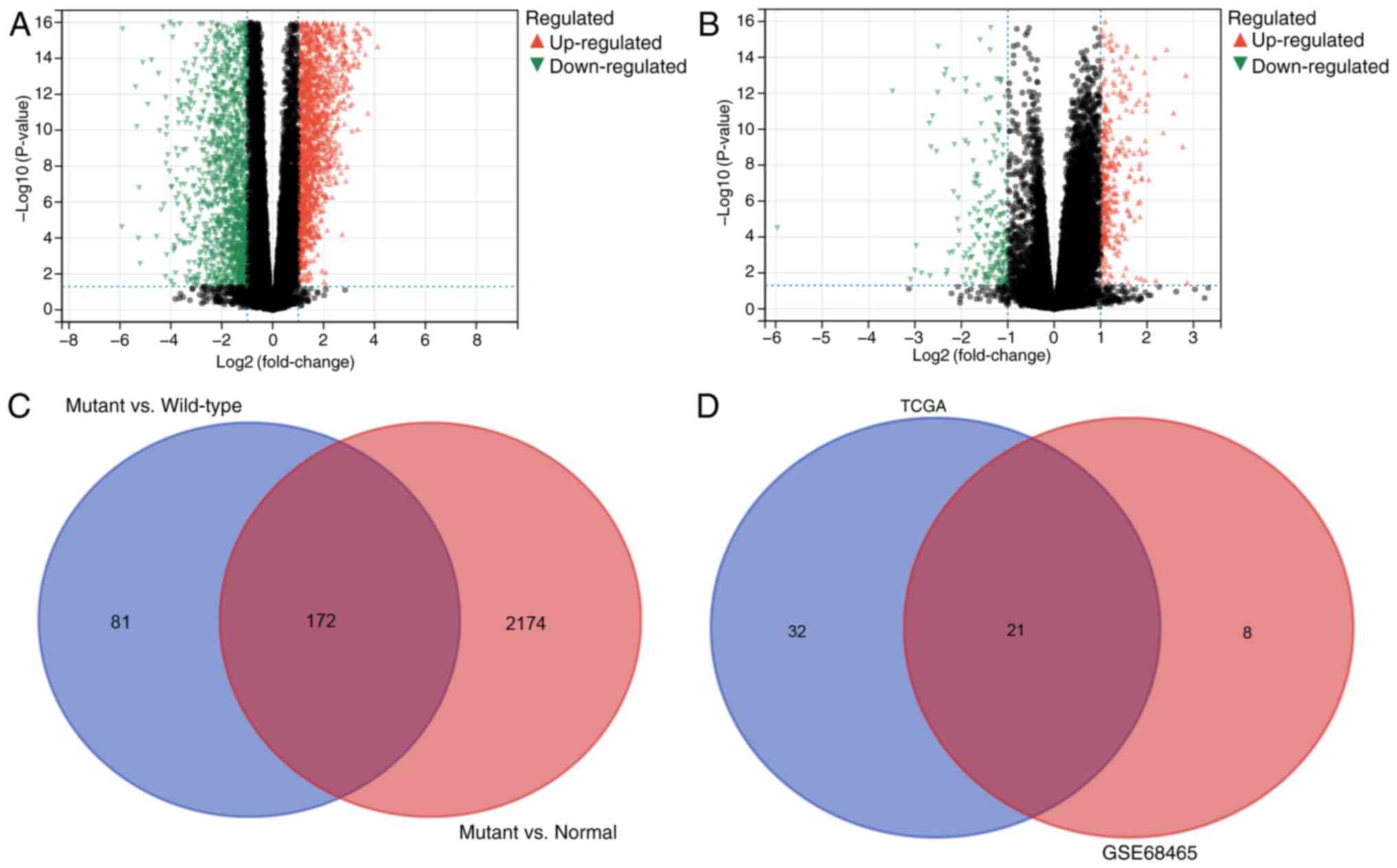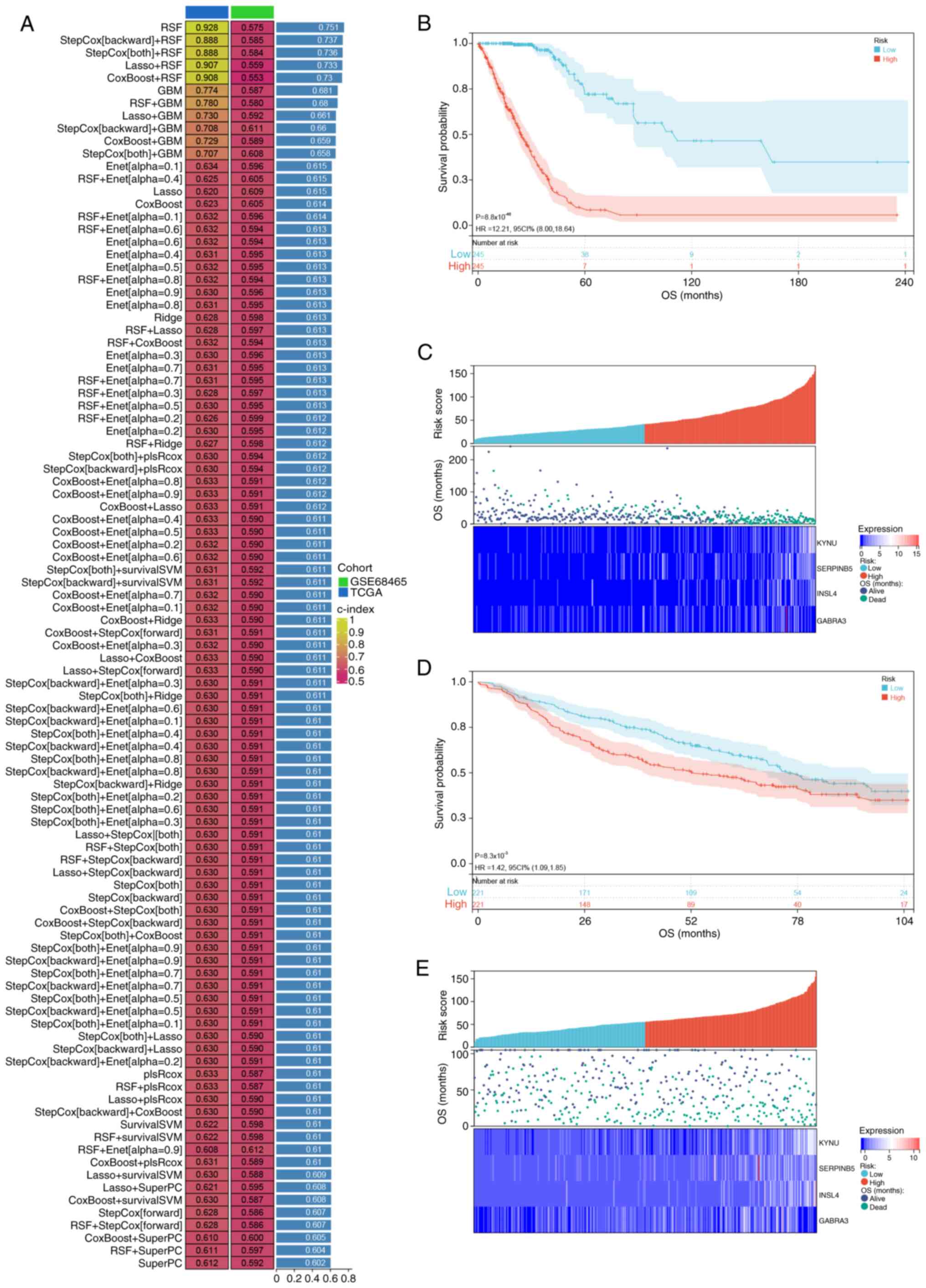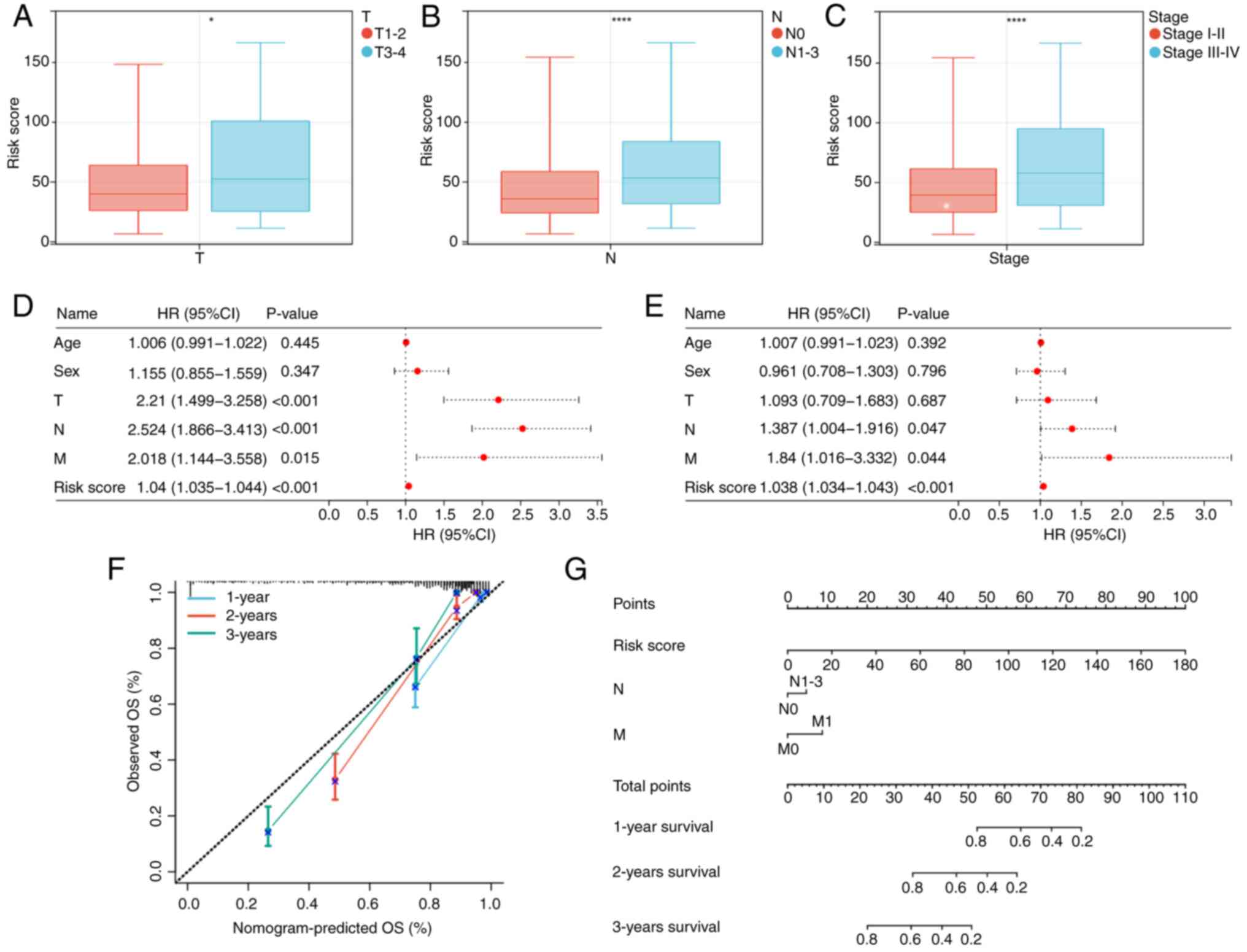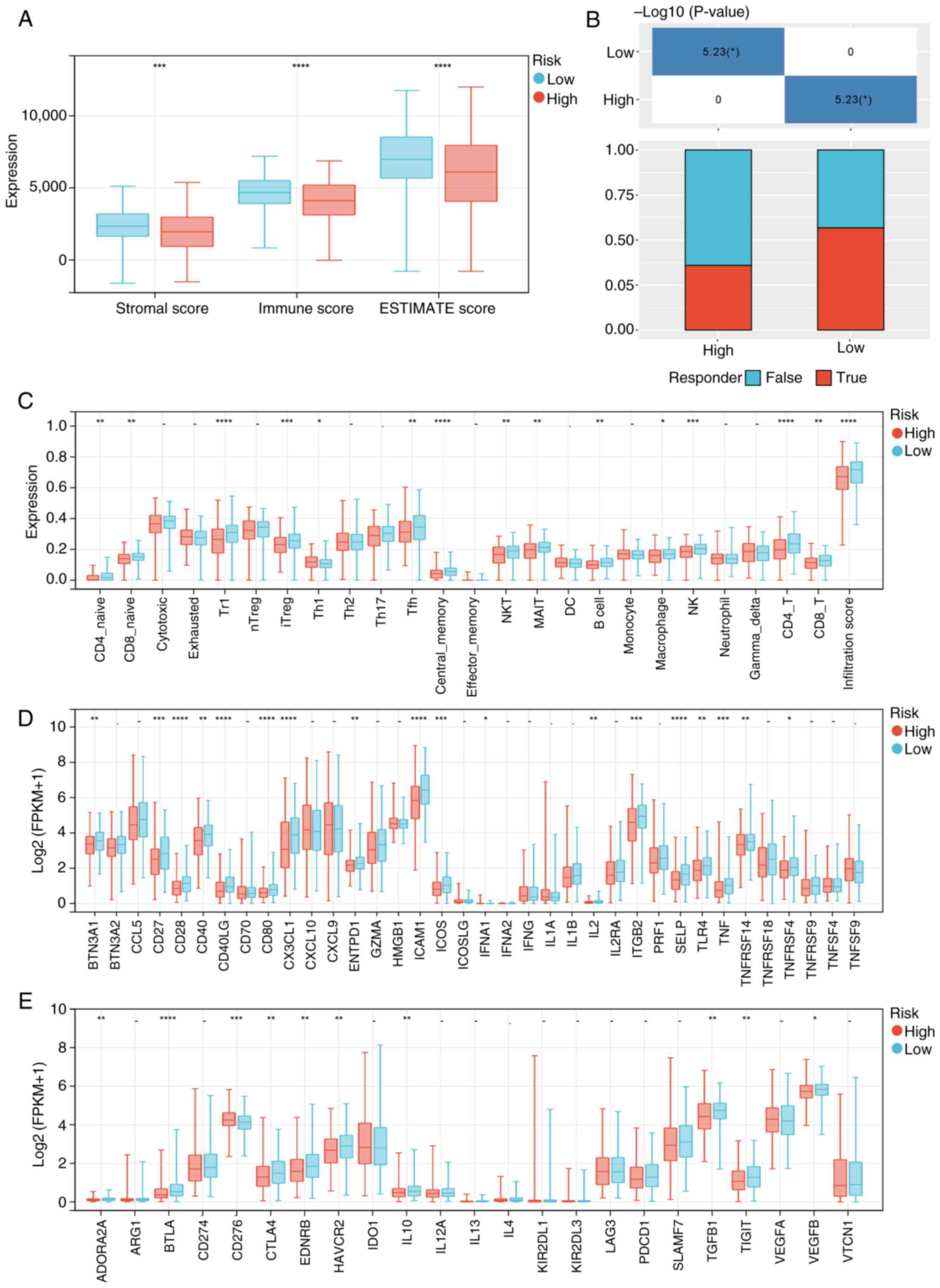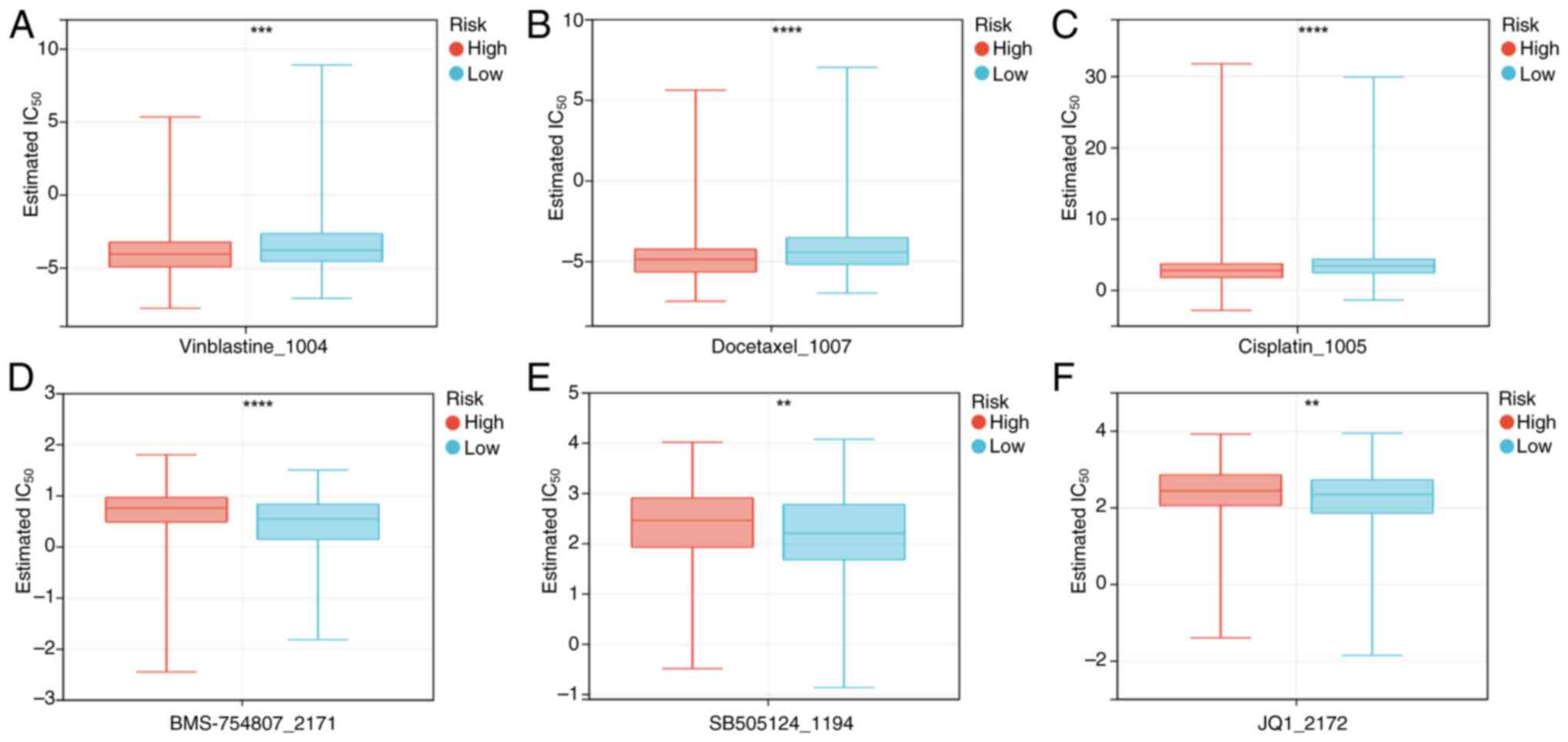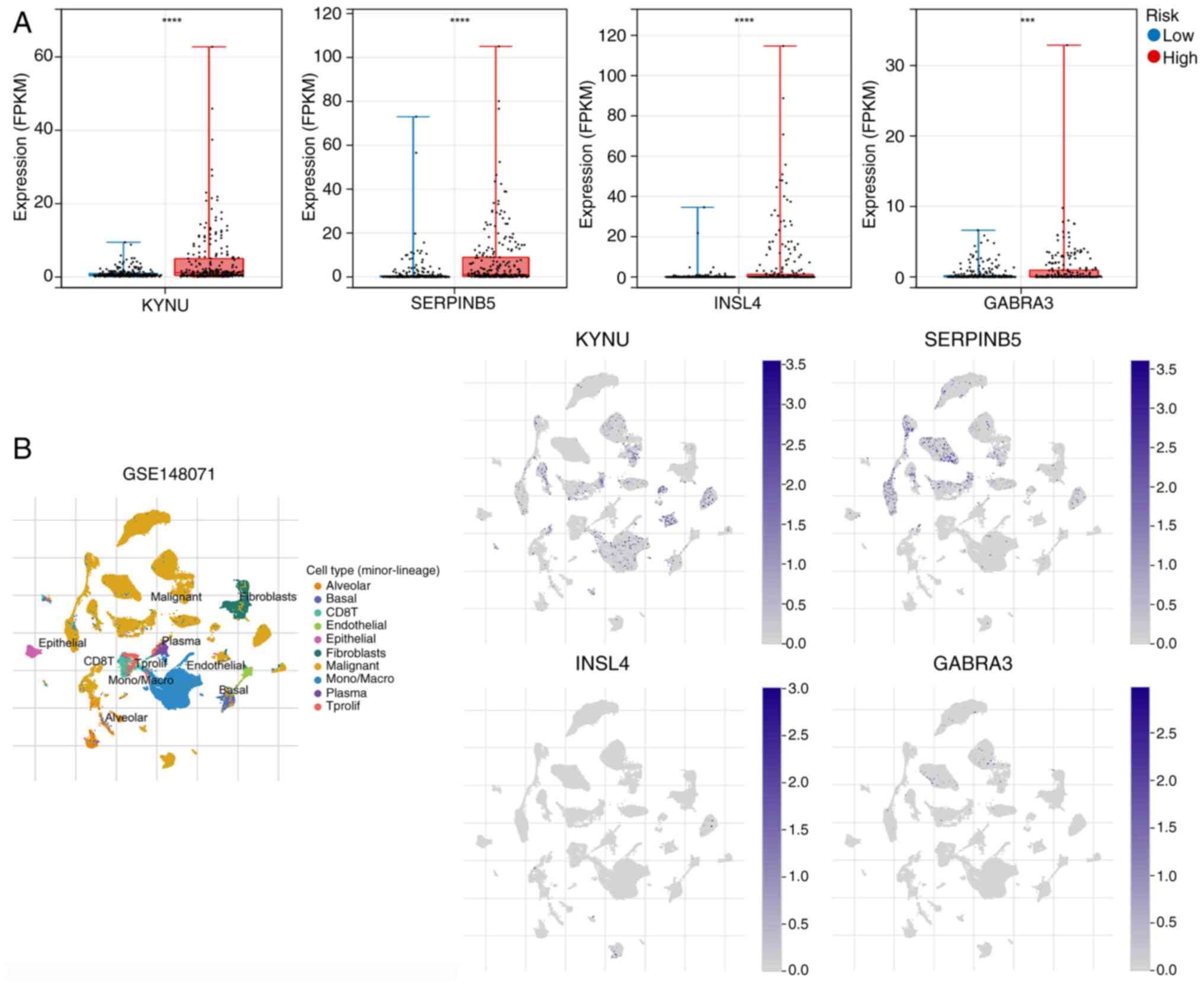Construction of a lung adenocarcinoma prognostic model based on KEAP1/NRF2/HO‑1 mutation‑mediated upregulated genes and bioinformatic analysis
- Authors:
- Published online on: January 23, 2025 https://doi.org/10.3892/ol.2025.14902
- Article Number: 155
-
Copyright: © Zhu et al. This is an open access article distributed under the terms of Creative Commons Attribution License.
Abstract
Introduction
Lung cancer is the most common malignant tumor, ranking as the second most prevalent and lethal malignant tumor globally (1). Lung cancer can be broadly classified into two main subtypes: i) Non-small cell lung cancer (NSCLC) and ii) small cell lung cancer, from both pathological and therapeutic perspectives. Lung adenocarcinoma (LUAD) is a pathological subtype of NSCLC, accounting for ~45% of all cases (2). Despite important advancements in molecular targeting, chemotherapy, radiation therapy and immunotherapy, the prognosis of LUAD remains unfavorable, with a 5-year overall survival rate of ~15% (3,4). Previous studies have demonstrated the pivotal role of genetic analysis in the diagnosis and treatment of lung cancer (5–7). For instance, the polymorphisms of the epidermal growth factor receptor are associated with side effects and outcome of tyrosine kinase inhibitor therapy administered to patients with NSCLC (5–7). Therefore, there is an urgent need for novel and effective screening methods based on genetic analysis to improve diagnostic accuracy and treatment efficiency, in order to improve the prognosis of patients with LUAD.
The Kelch like ECH associated protein 1 (KEAP1)/nuclear factor erythroid 2-related factor 2 (NRF2)/heme oxygenase 1 (HO-1) pathway serves a pivotal role in metabolic reprogramming, immune remodeling and treatment resistance in LUAD (8). In total, 20–30% of LUADs exhibit KEAP1 loss-of-function mutations, leading to aberrant activation of NRF2 and subsequently resulting in poor prognosis (9,10). KEAP1 mutations facilitate the progression of LUAD by augmenting glutamine metabolism and upregulating solute carrier family 33 member 1 expression (11,12). Furthermore, KEAP1-mutant tumors diminish dendritic cell and T cell responses, thus driving immunotherapy resistance in LUAD (13). NRF2, a transcription factor, serves a crucial role in the antioxidant pathway, promoting tumor cell growth, proliferation and drug resistance (14). NRF2 is the target of KEAP1 and abnormal activation of NRF2 is not only associated with KEAP1 mutations but also with gain-of-function mutations in NRF2 (15). Previous studies have found multiple gain-of-function mutation sites affecting NRF2 in LUAD (16). NRF2 mutations promote tumor cell immune escape by inhibiting stimulator of interferon response CGAMP interactor 1 activation (17). HO-1, which is regulated by NRF2, serves a crucial role as an antioxidant factor. When HO-1 expression is dysregulated, it can promote the proliferation of lung cancer cells and make them resistant to radiotherapy (18,19). However, several crucial and unresolved issues remain, encompassing the potential reclassification of LUAD based on KEAP1/NRF2/HO-1 mutations, the intricate interplay between KEAP1/NRF2/HO-1 mutations and the tumor microenvironment, as well as the strategic implementation of therapeutic interventions to effectively control tumor progression contingent upon KEAP1/NRF2/HO-1 mutations.
Therefore, the present study aimed to identify specific genes regulated by gene mutations of the KEAP1/NRF2/HO-1 axis and construct a prognostic model using upregulated genes. All patients were stratified into low- or high-risk groups based on the risk score, and the diagnostic efficacy was validated in both the training and test sets. Furthermore, the association between risk score and immune cell infiltration in the tumor microenvironment was explored and the individualized sensitivity to chemotherapy and immunotherapy were simultaneously predicted for each patient with LUAD.
Materials and methods
Validation of the expression of KEAP1, NRF2, HO-1 and Ki-67
Postoperative paraffin-embedded tissue blocks of patients with LUAD who underwent surgical procedures at Xishan People's Hospital of Wuxi City (Wuxi, China) between January 2020 and June 2023 were included in the present study. The inclusion criterion was a histologically confirmed diagnosis of LUAD, whilst the exclusion criteria were prior chemotherapy or radiation therapy. After selection, a total of 104 tissue wax blocks from patients with LUAD were included in the study. The patients consisted of 42 men and 62 women, with an mean age of 66.6 years (range, 32–92 years). The present study was approved by the Ethics Committee of Xishan People's Hospital (approval no. xs2023ky021).
Tissue sections (5 µm) were prepared and the expression of KEAP1, NRF2 and HO-1 was assessed using immunohistochemistry as previously described (19), using anti-KEAP1 (cat. no. ab226997; 1:100 dilution; Abcam), anti-NRF2 (cat. no. ab313825; 1:100; Abcam), anti-HO-1 (cat. no. ab137749; 1:100; Abcam) and anti-Ki-67 (cat. no. ab230460; 1:100; Abcam) antibodies as the primary antibodies. The Elivision™ plus Polyer HRP (mouse/rabbit) IHC Kit (cat. no. KIT-9902; Maixin Biotech. Co., Ltd.) served as the secondary antibody reagent in this study.
Data acquisition
High-throughput sequence-fragments per kilobase of transcript per million mapped reads data and clinicopathological information of patients with LUAD were acquired from The Cancer Genome Atlas (TCGA)-LUAD database (https://portal.gdc.cancer.gov/). Gene expression and survival data associated with the GSE68465 (20) dataset were obtained from the Gene Expression Omnibus (GEO) database (http://www.ncbi.nlm.nih.gov/geo/). Gene mutation information for KEAP1, NRF2 and HO-1 was retrieved from the cBio Cancer Genomics Portal (cBioPortal) website (http://www.cbioportal.org/). The association between KEAP1, NRF2 and HO-1 expression levels and patient survival was analyzed using the Kaplan-Meier Plotter website (https://kmplot.com/analysis/index.php?p=service) (21). All patients diagnosed with lung adenocarcinoma across the 17 datasets were included in this study. All possible cut-off values between the lower and upper quartiles were computed and the best performing threshold was used as a cut-off.
Identification of mutation-associated differentially expressed genes
Based on the mutation information obtained from the cBioPortal website, 112 tumor samples were classified into the mutation group, 403 tumor samples into the wild-type group and 59 normal pulmonary tissues into the normal group. The ‘limma’ package in R (version 4.1.3; http://www.r-project.org) was utilized to identify differentially expressed genes (log2 fold-change >1; P<0.05) by comparing gene expression between the mutant group and both the wild-type and normal groups (22).
Construction of a prognostic model
Candidate genes in the TCGA-LUAD and GSE68465 datasets were initially screened using univariate Cox analysis. Subsequently, 101 combinations of algorithms were used to construct a prognostic model based on the leave-one-out cross-validation framework (23). The TCGA-LUAD dataset was utilized as the training group, whilst the GSE68465 dataset served as the validation group. Furthermore, the consistency index (C-index) of each model was calculated in the validation group (23).
Survival analysis and nomogram construction based on clinical characteristics
Univariate and multivariate Cox regression analyses were used to identify independent prognostic factors in patients with LUAD. The ‘rms’ package in R (version 4.1.3) was utilized for constructing a nomogram based on risk score and two characteristic factors. Calibration curves were employed to evaluate the accuracy of these predictions. Additionally, decision curves generated using the ‘rmda’ package in R (version 4.1.3) were used to assess the predictive utility of the nomogram and to compare different prediction models.
Immune infiltration assessment and immunotherapy response prediction
The ‘ESTIMATE’ package in R (version 4.1.3) was used to evaluate the levels of immune cells and stromal cells in tumor tissues. The ImmuCellAI website (https://guolab.wchscu.cn/ImmuCellAI/#!/) was utilized for the analysis of immune cell types and levels within tumor tissues, facilitating a comparative assessment of immune cell levels between low- and high-risk groups (24). The effectiveness of immunotherapy in the aforementioned groups was evaluated through the prediction of individual response to immunotherapy among patients with LUAD.
Assessment of chemotherapy effectiveness
The ‘oncoPredict’ package in R (version 4.1.3) was used to predict chemotherapy drug sensitivity in patients with LUAD, aiming to compare the sensitivity to chemotherapy drugs between the high- and low-risk groups (25).
Expression of hub genes at the single-cell level
The Tumor Immune Single-cell Hub website (http://tisch1.comp-genomics.org/) was utilized to evaluate the expression of these hub genes in several cell types.
Statistical analysis
Statistical analyses were performed using R software (version 4.1.3). The Wilcoxon rank-sum test was used to determine the significance of differences between two groups. Frequency counts were used for statistical description of categorical (qualitative) data, and comparisons between groups were performed using either the χ2 test or the Fisher's exact test. All P-values were two-tailed. P<0.05 was considered to indicate a statistically significant difference.
Results
Association between KEAP, NRF2 and HO-1 expression and clinicopathology
The expression of KEAP1, NRF2 and HO-1 was assessed using immunohistochemistry based on 104 cases of LUAD and their association with pathological characteristics was evaluated. The immunohistochemical analysis revealed that KEAP1 and HO-1 were predominantly expressed in the cytoplasm, whereas NRF2 and Ki-67 were primarily localized in the nucleus (Fig. 1). No significant association was demonstrated between the expression of KEAP1 and clinical features (Table I). Compared to the NRF2-negative group, the NRF2-positive group exhibited enhanced tumor aggressiveness, higher proportions of lymph node and distant metastases, more advanced TNM stage (26) and increased proliferative activity (Table I). Compared to the HO-1-negative group, the HO-1-positive group exhibited significantly higher grades in T stage, N stage, M stage and the overall TNM staging system. Additionally, the HO-1 positive group demonstrated a larger tumor diameter and a markedly increased expression level of Ki-67 (Table I).
Table I.Association between KEAP1/NRF2/HO-1 expression and clinicopathological features in lung adenocarcinoma. |
Association between KEAP1, NRF2 and HO-1 expression and prognosis of patients with LUAD
The association between the expression of KEAP1, NRF2 and HO-1 and the prognosis of patients with LUAD was analyzed using the Kaplan-Meier Plotter website. The results indicated that, compared with low KEAP1 expression, high KEAP1 expression was not associated with overall survival (OS; Fig. 2A), but was significantly associated with improved first progression survival (FPS; Fig. 2B). Conversely, high expression of NRF2 and HO-1 was significantly associated with worse OS and FPS, in comparison with low NRF2 and HO-1 expression (Fig. 2C-F). The association between KEAP1, NRF2 and HO-1 expression levels and disease-specific survival (DSS), disease-free interval and progression-free interval (PFI) were further assessed based on data from the TCGA-LUAD dataset. The results revealed that only the expression of HO-1 was significantly associated with poor DSS and PFI (Fig. S1).
Identification of KEAP1/NRF2/HO-1 mutation-mediated upregulated genes (KNHMUGs)
From the cBioPortal database, KEAP1, NRF2 and HO-1 mutations in LUAD from TCGA pan-cancer atlas, which included 566 patients, were analyzed. Genetic alterations, such as in-frame, missense and truncation mutations of KEAP1 (19%), NRF2 (4%) and HO-1 (1.8%), were identified in patients with LUAD (Fig. 3). Based on the status of KEAP1/NRF2/HO-1 mutations, patients were classified into two groups: i) Mutant and ii) wild-type. Subsequently, the differential genes between the mutant, wild-type and normal groups were compared. A total of 2,346 upregulated genes specific to the mutant group were identified compared with the normal group (Fig. 4A), with 253 upregulated genes in the mutant group compared with the wild-type group (Fig. 4B). Furthermore, 172 common differentially upregulated genes in the mutant group were identified using a Venn diagram (Fig. 4C).
Prognostic model based on KNHMUGs
Univariate Cox regression analysis was then performed on 172 candidate genes in the TCGA and GSE68465 datasets. The TCGA dataset identified a total of 53 genes associated with prognosis, whereas the GSE68465 dataset revealed 29 genes that were prognostically relevant. Ultimately, an overlap of 21 genes with prognostic significance was observed in both datasets (Fig. 4D). Subsequently, these 21 genes were subjected to analysis using a combination of machine algorithms (101 combinations) with TCGA as the training set and GSE68465 as the validation set. By evaluating the C-index of both sets and considering the number of genes in optimal combinations, StepCox (backward) + random survival forest (RSF) algorithms emerged as the most effective prediction model (Fig. 5A), comprising four characterized genes, kynureninase (KYNU), serpin family B member 5 (SERPINB5), insulin like 4 (INSL4) and γ-aminobutyric acid type A receptor subunit α3 (GABRA3). Based on the median risk score, patients were stratified into high- and low-risk groups. Notably, OS was significantly lower for patients classified as high-risk compared with that for patients categorized as low-risk in both the TCGA [hazard ratio (HR), 12.21; 95% confidence interval (CI), 8.00–18.64; P<0.001] and GSE68465 (HR, 1.36; 95% CI, 1.05–1.75; P=0.012) datasets (Fig. 5B and D). It was also observed that the survival rate of patients significantly decreased as the risk score increased. Notably, the KYNU, SERPINB5, INSL4 and GABRA3 genes were identified as risk factors with an increasing trend in expression as the risk score rose (Fig. 5C and F).
Association between risk score and clinicopathological features
The association between risk score and clinicopathological characteristics was assessed. Patients with advanced-stage tumors [tumor stage (T) 3–4; lymph node stage (N)1-3; and stage III–IV] demonstrated a significantly higher risk score compared with those with early-stage tumors (T1-2; N0; and stage I–II), suggesting that this could be one of the factors contributing to the unfavorable prognosis observed in the high-risk group (Fig. 6A-C).
Construction of the nomogram
Univariate and multivariate Cox regression analyses were performed to assess the clinical characteristics and risk score of 490 patients (Fig. 6D and E). The results of the multivariate regression analysis revealed that risk score, N stage and metastasis (M) stage independently served as prognostic factors for patients with LUAD. Consequently, a nomogram was constructed based on these three independent risk factors (Fig. 6G) and calibration curves demonstrated a notable agreement between the predicted and actual values of the prediction model at 1, 2 and 3 years (Fig. 6F).
Association of risk score with immune infiltration and immunotherapy
The ESTIMATE results revealed that the low-risk group had significantly increased stromal and immune scores compared with the high-risk group, indicating a higher level of immune cell infiltration within this group (Fig. 7A). Subsequently, further analysis on immune cell infiltration in tumor tissues was performed. It was revealed that the low-risk group exhibited significantly enhanced infiltration of CD4+ naive, CD8+ naive, CD4+ T, CD8+ T, natural killer (NK), NKT cells and other immune cells compared with the high-risk group (Fig. 7C). Additionally, the expression levels of immune checkpoint-related genes were assessed. Notably, the low-risk group demonstrated a significantly increased expression of immune checkpoint-stimulated genes such as CD27, CD80 and C-X3-C motif chemokine ligand 1, as well as immune checkpoint-inhibited genes such as cytotoxic T-lymphocyte associated protein 4 (CTLA4) and hepatitis A virus cellular receptor 2 (HAVCR2), compared with the high-risk group (Fig. 7D and E). Furthermore, the efficacy of immunotherapy in different subgroups was predicted, and it was revealed that immune-checkpoint blockade therapy response prediction indicated a higher rate of response in the low-risk group compared with that in the high-risk group (Fig. 7B).
Association of risk score with drug therapy
The ‘oncoPredict’ R package was used to compare the differences in chemotherapy sensitivity between the high- and low-risk groups. The results demonstrated that the high-risk group had a significantly increased sensitivity to vincristine, docetaxel and cisplatin, whilst the low-risk group exhibited a significantly increased sensitivity to BMS_754807 (insulin receptor inhibitor), SB505124_1194 (TGF-β receptor inhibitor) and JQ1_2172 [bromodomain and extraterminal (BET) inhibitor] (Fig. 8).
Expression of hub genes in different risk groups and their localization in LUAD
To analyze the expression of hub genes in different risk groups, the mRNA expression levels of hub genes were assessed. The findings revealed that KYNU, SERPINB5, INSL4 and GABRA3 were significantly upregulated in the high-risk group compared with that of the low-risk group (P<0.05; Fig. 9A). Additionally, the Tumor Immune Single-cell Hub website was utilized to evaluate the expression of these hub genes in several cell types. Annotation analysis of the GSE148071 single-cell dataset demonstrated that tumor tissue consists of diverse cells, including malignant cells, epithelial cells and fibroblasts. Notably, KYNU, SERPINB5, INSL4 and GABRA3 exhibited a predominant expression in malignant cells (Fig. 9B). These results suggest that these hub genes primarily contribute to LUAD progression by modulating biological functions, specifically within malignant cells.
Discussion
A total of 20–30% LUAD tumors carry mutations in KEAP1 and NRF2. Both loss-of-function mutations in KEAP1 and gain-of-function mutations in NFE2-like BZIP transcription factor 2 can activate the KEAP1/NRF2 pathway in LUAD (15). Previous studies have demonstrated that the KEAP1/NRF2/HO-1 axis inhibits cisplatin-induced ferroptosis by upregulating the iron death-related genes solute carrier family 7 member 11 and NAD(P)H quinone dehydrogenase 1 (27,28). Furthermore, the NRF2/HO-1 axis could attenuate resistance to programmed cell death 1 immunotherapy by inhibiting the transformation of M2 into M1 macrophages (29). Notably, KEAP1/NRF2 mutations are considered a pivotal driver of immune-suppressive tumor microenvironment metabolic reprogramming in LUAD, including potent induction of T-regulatory cells and diminishing the number of dendritic cells and tissue-resident memory CD8+ T cells, thereby compromising the efficacy of immunotherapy (13,30,31). However, combination therapy involving glutaminase inhibition and immune checkpoint blockade is reported to hold promise for reversing the immune suppression mediated by KEAP1/NRF2 mutations (13,30). Mutations in the KEAP1/NRF2/HO-1 genes serve a crucial role in the development of LUAD. However, there is a lack of established clinical models to assess the prognosis, tumor microenvironment and response to chemotherapy and immunotherapy in patients with LUAD based on genes regulated by KEAP1/NRF2/HO-1 mutations.
The prognostic model in the present study consisted of four genes: KYNU, SERPINB5, INSL4 and GABRA3. KYNU acts as a key enzyme in tryptophan metabolism, and its metabolite 3-hydroxyanthranilic acid is notably associated with poor prognosis in patients with NSCLC (32,33). Further research reported that NRF2 upregulated KYNU, which was positively associated with an inhibitory tumor microenvironment (34). SERPINB2 belongs to the family of protease inhibitors, which is associated with tumorigenesis and regulation of several vital biological processes (35,36). The expression of SERPINB5 has been reported to be upregulated in LUAD, and its high expression levels were notably associated with poor OS. Furthermore, overexpression of SERPINB5 promoted cell proliferation, migration and invasion and epithelial-mesenchymal transition (EMT) in LUAD cells (37). INSL4 is a member of the insulin superfamily, which includes genes for insulin, insulin-like growth factors and relaxin. In LUAD, high levels of INSL4 expression have been reported to be associated with poor prognosis (38). Increased expression of INSL4 can promote tumor cell proliferation and invasion (38,39). GABRA3 acts as a key chloride ion transporter and also functions as a subunit of γ-aminobutyric acid A receptors (40). In LUAD, increased expression of GABRA3 has been closely associated with poor prognosis. By upregulating the expression of MMP-2 and MMP-9 via activation of the JNK/activator protein-1 signaling pathway, GABRA3 facilitates lymphatic metastasis in LUAD (41). Therefore, the aforementioned four genes are associated with the pathogenesis and progression of LUAD and may be considered potential therapeutic targets. Currently, there are studies investigating the regulatory association between KEAP1, NRF2 and HO-1 and KYNU (34). Subsequent research should further explore the interaction between KEAP1, NRF2 and HO-1, and SERPINB5, along with INSL4 and GABRA3.
The tumor microenvironment consists of diverse immune cells, stromal cells, extracellular matrix and several cytokines (42). These different components not only impact patient prognosis but also have a close association with immunotherapy (43). The present study revealed that the low-risk group exhibited a higher percentage of infiltration of CD4+ T, CD8+ T, NK and NKT cells compared with the high-risk group. Previous research has demonstrated that an increased presence of CD4+ T and CD8+ T cells is associated with improved prognosis and enhanced immunotherapeutic efficacy (44). NK cells are a subset of innate immune cells capable of rapidly recognizing and eliminating tumor cells whilst also promoting adaptive T-cell immune responses to suppress tumor aggressiveness (45). NKT cells represent a class of lymphocytes expressing both NK and T cell surface markers. They serve as a link between intrinsic and adaptive immunity and serve a crucial role in the tumor immune microenvironment (46). Therefore, increased infiltration of these cells may explain why the low-risk group exhibited improved prognosis compared with the high-risk group.
At present, research on immune checkpoint inhibitors is a hot topic. The current study assessed the expression of immune checkpoint suppressor genes in both the high- and low-risk groups. The results revealed high expression of immune checkpoint inhibitors, including CTLA4, T cell immunoreceptor with Ig and ITIM domains (TIGIT), HAVCR2 and B and T lymphocyte associated protein (BTLA) in the low-risk group. CTLA4 is a suppressor molecule located on the surface of T cells that can promote tumor tolerance and T-cell exhaustion when abnormally expressed (47). TIGIT is an immune checkpoint gene expressed on several types of T and NK cells. Its binding to CD155 on immune-suppressive cells or tumor cell surfaces inhibits immune cell function (48). HAVCR2, as a negatively regulated immune checkpoint, not only regulates the exhaustion of T and NK cells, but also regulates the intrinsic immune escape of tumors mediated by macrophages and dendritic cells (49). BTLA is a suppressor expressed on the surface of immune cells such as T and B cells. Upon binding to herpesvirus entry mediator, it sends inhibitory signals to T cells, leading to a decrease in T cell proliferation and activation (50). These findings indicate that there are more immunotherapeutic targets within the low-risk group with higher potential benefits from immunotherapy compared with the high-risk group, aligning with the predicted response rate for immunotherapy.
Notably, chemotherapy is a crucial component of LUAD treatment. Half-maximal inhibitory concentration analysis was performed to screen potential compounds and the findings revealed that the high-risk group exhibited greater sensitivity to vincristine, docetaxel and cisplatin, whilst the low-risk group showed increased sensitivity to BMS_754807, SB505124_1194 and JQ1_2172. Clinically, vincristine, docetaxel and cisplatin are commonly utilized chemotherapeutic agents for LUAD treatment, which are often administered in combination to enhance patient prognosis (51). BMS-754807 is a potent inhibitor of the insulin-like growth factor 1 receptor/insulin receptor family of kinases that synergistically interacts with platinum-based chemotherapeutics to induce apoptosis in lung cancer cells (52). Furthermore, dasatinib combined with BMS-754807 could inhibit lung cancer cell proliferation by inducing autophagy and arresting the cell cycle at G1 phase (53). SB505124_1194 is a selective TGF-β1 receptor inhibitor that notably impedes TGF-β1-mediated EMT in lung cancer cells, thereby reducing recurrence and metastasis (54,55). In the present study, higher expression of TGF-β1 in the low-risk group was associated with drug prediction. JQ1_2172 is a small molecule inhibitor targeting the BET protein that binds reversibly to its bromodomain, thus disrupting its interaction with acetylated lysines on histones or transcription factors. This inhibition leads to the suppression of oncogene expression, ultimately resulting in cancer cell proliferation arrest (56). Additionally, JQ1_2172 inhibits the upregulation of programmed death-ligand 1 during concurrent radiotherapy for lung cancer, thus exerting antitumor immune escape effects (57). Despite their effective eradication of tumor cells, anti-neoplastic drugs exert certain effects on both patients and hospital workers exposed to them, including increased DNA damage, elevated oxidative stress parameters and impairment on complete blood counts (58). Therefore, the implementation of personalized treatment strategies based on risk score could facilitate the selection of appropriate drug treatment plans, thereby enhancing treatment efficacy and minimizing the adverse effects of anti-neoplastic drugs on patients and healthcare workers.
Although a robust prognostic model based on KNHMUGs was constructed in the present study using public data, it is relied on public databases and further clinical validation is therefore required to confirm the model efficacy in prognostic prediction and assessment of immunotherapy and chemotherapy sensitivity. Secondly, whilst the hub genes screened in the present study have been investigated in a small number of LUAD cases, their mechanisms remain unclear and require further exploration. Subsequent studies should be conducted to address the aforementioned questions.
In summary, KEAP1, NRF2 and HO-1 expression is closely associated with clinicopathological features and prognosis in LUAD. The prognostic model constructed based on KNHMUGs may serve as an independent prognostic factor for predicting the prognosis of patients with LUAD. It integrates important clinical parameters and risk scores of prognoses, demonstrating reliability and effectiveness. Furthermore, the association between risk score and tumor immune microenvironment, immunotherapy and chemotherapy response may offer a potentially powerful new tool for clinical decision-making, patient prognosis determination and personalized treatment.
Supplementary Material
Supporting Data
Acknowledgements
Not applicable.
Funding
The present research was supported by the scientific research projects of the Top Talent Support Program for Young and Middle-Aged People of Wuxi Health Committee (grant no. HB2023116) and the Innovation Cultivation Fund of Xishan People's Hospital (grant no. 202103).
Availability of data and materials
The data generated in the present study may be requested from the corresponding author.
Authors' contributions
ZX designed the research and drafted the manuscript. CC and QS utilized software code to perform an in-depth analysis and visualization of the data and reviewed the present paper. WZ and YZ analyzed the paraffin sections. LY designed the mathematical methods, collected and analyzed the data. LC performed the immunohistochemistry. WZ and ZX confirm the authenticity of all the raw data. All authors read and approved the final manuscript.
Ethics approval and consent to participate
The present study complied with the Declaration of Helsinki and was approved by the Xishan People's Hospital Ethics Committee (approval no. xs2024ky037). The samples used in the present study were sourced from Xishan People's Hospital in Wuxi City, collected from patients with LUAD undergoing surgery between January 2020 and June 2023. Written informed consent forms were signed by all patients.
Patient consent for publication
Not applicable.
Competing interests
The authors declare that they have no competing interests.
References
|
Sung H, Ferlay J, Siegel RL, Laversanne M, Soerjomataram I, Jemal A and Bray F: Global cancer statistics 2020: GLOBOCAN estimates of incidence and mortality worldwide for 36 cancers in 185 countries. CA Cancer J Clin. 71:209–249. 2021. View Article : Google Scholar : PubMed/NCBI | |
|
Denisenko TV, Budkevich IN and Zhivotovsky B: Cell death-based treatment of lung adenocarcinoma. Cell Death Dis. 9:1172018. View Article : Google Scholar : PubMed/NCBI | |
|
Reck M and Rabe KF: Precision diagnosis and treatment for advanced non-small-cell lung cancer. N Engl J Med. 377:849–861. 2017. View Article : Google Scholar : PubMed/NCBI | |
|
Li Y, Yan B and He S: Advances and challenges in the treatment of lung cancer. Biomed Pharmacother. 169:1158912023. View Article : Google Scholar : PubMed/NCBI | |
|
Obradovic J, Todosijevic J and Jurisic V: Application of the conventional and novel methods in testing EGFR variants for NSCLC patients in the last 10 years through different regions: A systematic review. Mol Biol Rep. 48:3593–3604. 2021. View Article : Google Scholar : PubMed/NCBI | |
|
Jurisic V, Vukovic V, Obradovic J, Gulyaeva LF, Kushlinskii NE and Djordjevic N: EGFR polymorphism and survival of NSCLC patients treated with TKIs: A systematic review and meta-analysis. J Oncol. 2020:19732412020. View Article : Google Scholar : PubMed/NCBI | |
|
Obradovic J, Todosijevic J and Jurisic V: Side effects of tyrosine kinase inhibitors therapy in patients with non-small cell lung cancer and associations with EGFR polymorphisms: A systematic review and meta-analysis. Oncol Lett. 25:622023. View Article : Google Scholar : PubMed/NCBI | |
|
Xu K, Ma J, Hall SRR, Pengs RW, Yang H and Yao F: Battles against aberrant KEAP1-NRF2 signaling in lung cancer: Intertwined metabolic and immune networks. Theranostics. 13:704–723. 2023. View Article : Google Scholar : PubMed/NCBI | |
|
Ghareghomi S, Moosavi-Movahedi F, Saso L, Habibi-Rezaei M, Khatibi A, Hong J and Moosavi-Movahedi AA: Modulation of Nrf2/HO-1 by natural compounds in lung cancer. Antioxidants (Basel). 12:7352023. View Article : Google Scholar : PubMed/NCBI | |
|
Imielinski M, Berger AH, Hammerman PS, Hernandez B, Pugh TJ, Hodis E, Cho J, Suh J, Capelletti M, Sivachenko A, et al: Mapping the hallmarks of lung adenocarcinoma with massively parallel sequencing. Cell. 150:1107–1120. 2012. View Article : Google Scholar : PubMed/NCBI | |
|
Romero R, Sanchez-Rivera FJ, Westcott PMK, Mercer KL, Bhutkar A, Muir A, Robles TJ, Rodriguez SL, Liao LZ, Ng SR, et al: Keap1 mutation renders lung adenocarcinomas dependent on Slc33a1. Nat Cancer. 1:589–602. 2020. View Article : Google Scholar : PubMed/NCBI | |
|
Romero R, Sayin VI, Davidson SM, Bauer MR, Singh SX, LeBoeuf SE, Karakousi TR, Ellis DC, Bhutkar A, Sanchez-Rivera FJ, et al: Keap1 loss promotes Kras-driven lung cancer and results in dependence on glutaminolysis. Nat Med. 23:1362–1368. 2017. View Article : Google Scholar : PubMed/NCBI | |
|
Zavitsanou AM, Pillai R, Hao Y, Wu WL, Bartnicki E, Karakousi T, Rajalingam S, Herrera A, Karatza A, Rashidfarrokhi A, et al: KEAP1 mutation in lung adenocarcinoma promotes immune evasion and immunotherapy resistance. Cell Rep. 42:1132952023. View Article : Google Scholar : PubMed/NCBI | |
|
Ghareghomi S, Habibi-Rezaei M, Arese M, Saso L and Moosavi-Movahedi AA: Nrf2 modulation in breast cancer. Biomedicines. 10:26682022. View Article : Google Scholar : PubMed/NCBI | |
|
Menegon S, Columbano A and Giordano S: The dual roles of NRF2 in cancer. Trends Mol Med. 22:578–593. 2016. View Article : Google Scholar : PubMed/NCBI | |
|
Kerins MJ and Ooi A: A catalogue of somatic NRF2 gain-of-function mutations in cancer. Sci Rep. 8:128462018. View Article : Google Scholar : PubMed/NCBI | |
|
Li C, Liang G, Yan K and Wang Y: NRF2 mutation enhances the immune escape of hepatocellular carcinoma by reducing STING activation. Biochem Biophys Res Commun. 698:1495362024. View Article : Google Scholar : PubMed/NCBI | |
|
Tang H, Liu S, Yan X, Jin Y, He X, Huang H, Liu L, Hu W and Wu A: Inhibition of LNC EBLN3P enhances radiation-induced mitochondrial damage in lung cancer cells by targeting the Keap1/Nrf2/HO-1 axis. Biology (Basel). 12:12082023.PubMed/NCBI | |
|
Spampinato M, Sferrazzo G, Pittala V, Di Rosa M, Vanella L, Salerno L, Sorrenti V, Carota G, Parrinello N, Raffaele M, et al: Non-competitive heme oxygenase-1 activity inhibitor reduces non-small cell lung cancer glutathione content and regulates cell proliferation. Mol Biol Rep. 47:1949–1964. 2020. View Article : Google Scholar : PubMed/NCBI | |
|
Director's Challenge Consortium for the Molecular Classification of Lung Adenocarcinoma, Shedden K, Taylor JM, Enkemann SA, Tsao MS, Yeatman TJ, Gerald WL, Eschrich S, Jurisica I, Giordano TJ, et al: Gene expression-based survival prediction in lung adenocarcinoma: A multi-site, blinded validation study. Nat Med. 14:822–827. 2008. View Article : Google Scholar | |
|
Lanczky A and Gyorffy B: Web-based survival analysis tool tailored for medical research (KMplot): Development and implementation. J Med Internet Res. 23:e276332021. View Article : Google Scholar : PubMed/NCBI | |
|
Ritchie ME, Phipson B, Wu D, Hu Y, Law CW, Shi W and Smyth GK: limma powers differential expression analyses for RNA-sequencing and microarray studies. Nucleic Acids Res. 43:e472015. View Article : Google Scholar : PubMed/NCBI | |
|
Liu Z, Liu L, Weng S, Guo C, Dang Q, Xu H, Wang L, Lu T, Zhang Y, Sun Z and Han X: Machine learning-based integration develops an immune-derived lncRNA signature for improving outcomes in colorectal cancer. Nat Commun. 13:8162022. View Article : Google Scholar : PubMed/NCBI | |
|
Miao YR, Zhang Q, Lei Q, Luo M, Xie GY, Wang H and Guo AY: ImmuCellAI: A unique method for comprehensive T-cell subsets abundance prediction and its application in cancer immunotherapy. Adv Sci (Weinh). 7:19028802020. View Article : Google Scholar : PubMed/NCBI | |
|
Maeser D, Gruener RF and Huang RS: oncoPredict: An R package for predicting in vivo or cancer patient drug response and biomarkers from cell line screening data. Brief Bioinform. 22:bbab2602021. View Article : Google Scholar : PubMed/NCBI | |
|
Detterbeck FC, Woodard GA, Bader AS, Dacic S, Grant MJ, Park HS and Tanoue LT: The proposed ninth edition TNM classification of lung cancer. Chest. 166:882–895. 2024. View Article : Google Scholar : PubMed/NCBI | |
|
Lou JS, Zhao LP, Huang ZH, Chen XY, Xu JT, Tai WC, Tsim KWK, Chen YT and Xie T: Ginkgetin derived from Ginkgo biloba leaves enhances the therapeutic effect of cisplatin via ferroptosis-mediated disruption of the Nrf2/HO-1 axis in EGFR wild-type non-small-cell lung cancer. Phytomedicine. 80:1533702021. View Article : Google Scholar : PubMed/NCBI | |
|
Bi G, Liang J, Zhao M, Zhang H, Jin X, Lu T, Zheng Y, Bian Y, Chen Z, Huang Y, et al: miR-6077 promotes cisplatin/pemetrexed resistance in lung adenocarcinoma via CDKN1A/cell cycle arrest and KEAP1/ferroptosis pathways. Mol Ther Nucleic Acids. 28:366–386. 2022. View Article : Google Scholar : PubMed/NCBI | |
|
Mei L, Long J, Wu S, Mei M, Mei D and Qiu H: APOC1 reduced anti-PD-1 immunotherapy of nonsmall cell lung cancer via the transformation of M2 into M1 macrophages by ferroptosis by NRF2/HO-1. Anticancer Drugs. 35:333–343. 2024. View Article : Google Scholar : PubMed/NCBI | |
|
Wei XW, Lu C, Zhang YC, Fan X, Xu CR, Chen ZH, Wang F, Yang XR, Deng JY, Yang M, et al: Redox(high) phenotype mediated by KEAP1/STK11/SMARCA4/NRF2 mutations diminishes tissue-resident memory CD8+ T cells and attenuates the efficacy of immunotherapy in lung adenocarcinoma. Oncoimmunology. 13:23401542024. View Article : Google Scholar : PubMed/NCBI | |
|
Fahrmann JF, Tanaka I, Irajizad E, Mao X, Dennison JB, Murage E, Casabar J, Mayo J, Peng Q, Celiktas M, et al: Mutational activation of the NRF2 pathway upregulates kynureninase resulting in tumor immunosuppression and poor outcome in lung adenocarcinoma. Cancers (Basel). 14:25432022. View Article : Google Scholar : PubMed/NCBI | |
|
Phillips RS: Structure and mechanism of kynureninase. Arch Biochem Biophys. 544:69–74. 2014. View Article : Google Scholar : PubMed/NCBI | |
|
Karayama M, Masuda J, Mori K, Yasui H, Hozumi H, Suzuki Y, Furuhashi K, Fujisawa T, Enomoto N, Nakamura Y, et al: Comprehensive assessment of multiple tryptophan metabolites as potential biomarkers for immune checkpoint inhibitors in patients with non-small cell lung cancer. Clin Transl Oncol. 23:418–423. 2021. View Article : Google Scholar : PubMed/NCBI | |
|
Leon-Letelier RA, Sater AH, Chen Y, Srejbhjv S, et al: Kynureninase upregulation is a prominent feature of NFR2-activated cancers and is associated with tumor immunosuppression and poor prognosis. Cancers (Basel). 15:8342023. View Article : Google Scholar : PubMed/NCBI | |
|
Liu BX, Xie Y, Zhang J, Zeng S, Li J, Tao Q, Yang J, Chen Y and Zeng C: SERPINB5 promotes colorectal cancer invasion and migration by promoting EMT and angiogenesis via the TNF-α/NF-κB pathway. Int Immunopharmacol. 131:1117592024. View Article : Google Scholar : PubMed/NCBI | |
|
Rathod M, Franz H, Beyersdorfer V, Wanuske MT, Leal-Fischer K, Hanns P, Stüdle C, Zimmermann A, Buczak K, Schinner C and Spindler V: DPM1 modulates desmosomal adhesion and epidermal differentiation through SERPINB5. J Cell Biol. 223:e2023050062024. View Article : Google Scholar : PubMed/NCBI | |
|
He X, Ma Y, Huang Z, Wang G, Wang W, Zhang R, Guo G, Zhang X, Wen Y and Zhang L: SERPINB5 is a prognostic biomarker and promotes proliferation, metastasis and epithelial-mesenchymal transition (EMT) in lung adenocarcinoma. Thorac Cancer. 14:2275–2287. 2023. View Article : Google Scholar : PubMed/NCBI | |
|
Scopetti D, Piobbico D, Brunacci C, Pieroni S, Bellezza G, Castelli M, Ludovini V, Tofanetti FR, Cagini L, Sidoni A, et al: INSL4 as prognostic marker for proliferation and invasiveness in non-small-cell lung cancer. J Cancer. 12:3781–3795. 2021. View Article : Google Scholar : PubMed/NCBI | |
|
Yang R, Li SW, Chen Z, Zhou X, Ni W, Fu DA, Lu J, Kaye FJ and Wu L: Role of INSL4 signaling in sustaining the growth and viability of LKB1-inactivated lung cancer. J Natl Cancer Inst. 111:664–674. 2019. View Article : Google Scholar : PubMed/NCBI | |
|
Bhattacharya D, Gawali VS, Kallay L, Toukam DK, Koehler A, Stambrook P, Krummel DP and Sengupta S: Therapeutically leveraging GABA(A) receptors in cancer. Exp Biol Med (Maywood). 246:2128–2135. 2021. View Article : Google Scholar : PubMed/NCBI | |
|
Liu L, Yang C, Shen J, Huang L, Lin W, Tang H, Liang W, Shao W, Zhang H and He J: GABRA3 promotes lymphatic metastasis in lung adenocarcinoma by mediating upregulation of matrix metalloproteinases. Oncotarget. 7:32341–32350. 2016. View Article : Google Scholar : PubMed/NCBI | |
|
Hanahan D and Coussens LM: Accessories to the crime: Functions of cells recruited to the tumor microenvironment. Cancer Cell. 21:309–322. 2012. View Article : Google Scholar : PubMed/NCBI | |
|
Binnewies M, Roberts EW, Kersten K, Chan V, Fearon DF, Merad M, Coussens LM, Gabrilovich DI, Ostrand-Rosenberg S, Hedrick CC, et al: Understanding the tumor immune microenvironment (TIME) for effective therapy. Nat Med. 24:541–550. 2018. View Article : Google Scholar : PubMed/NCBI | |
|
Genova C, Dellepiane C, Carrega P, Sommariva S, Ferlazzo G, Pronzato P, Gangemi R, Filaci G, Coco S and Croce M: Therapeutic implications of tumor microenvironment in lung cancer: Focus on immune checkpoint blockade. Front Immunol. 12:7994552021. View Article : Google Scholar : PubMed/NCBI | |
|
Song P, Li W, Guo L, Ying J, Gao S and He J: Identification and validation of a novel signature based on NK cell marker genes to predict prognosis and immunotherapy response in lung adenocarcinoma by integrated analysis of single-cell and bulk RNA-sequencing. Front Immunol. 13:8507452022. View Article : Google Scholar : PubMed/NCBI | |
|
Terabe M and Berzofsky JA: Tissue-specific roles of NKT cells in tumor immunity. Front Immunol. 9:18382018. View Article : Google Scholar : PubMed/NCBI | |
|
Rad SH, Monkman J, Warkiani ME, Ladwa R, O'Byrne K, Rezaei N and Kulasinghe A: Understanding the tumor microenvironment for effective immunotherapy. Med Res Rev. 41:1474–1498. 2021. View Article : Google Scholar : PubMed/NCBI | |
|
Ge Z, Peppelenbosch MP, Sprengers D and Kwekkeboom J: TIGIT, the next step towards successful combination immune checkpoint therapy in cancer. Front Immunol. 12:6998952021. View Article : Google Scholar : PubMed/NCBI | |
|
Acharya N, Sabatos-Peyton C and Anderson AC: Tim-3 finds its place in the cancer immunotherapy landscape. J Immunother Cancer. 8:e0009112020. View Article : Google Scholar : PubMed/NCBI | |
|
Wojciechowicz K, Spodzieja M and Wardowska A: The BTLA-HVEM complex-The future of cancer immunotherapy. Eur J Med Chem. 268:1162312024. View Article : Google Scholar : PubMed/NCBI | |
|
Gebbia V, Lorusso V, Galetta D, Caruso MM, Palomba G, Riccardi F, Borsellino N, Carrozza F, Leo S, Ferraù F, et al: First-line cisplatin with docetaxel or vinorelbine in patients with advanced non-small-cell lung cancer: A quality of life directed phase II randomized trial of Gruppo Oncologico Italia Meridionale. Lung Cancer. 69:218–224. 2010. View Article : Google Scholar : PubMed/NCBI | |
|
Fuentes-Baile M, Ventero MP, Encinar JA, García-Morales P, Poveda-Deltell M, Pérez-Valenciano E, Barberá VM, Gallego-Plazas J, Rodríguez-Lescure Á, Martín-Nieto J and Saceda M: Differential effects of IGF-1r small molecule tyrosine kinase inhibitors BMS-754807 and OSI-906 on human cancer cell lines. Cancers (Basel). 12:37172020. View Article : Google Scholar : PubMed/NCBI | |
|
Zhang C, Zhao X, Wang Z, Gong T, Zhao H, Zhang D, Niu Y, Li X, Zhao X, Li G, et al: Dasatinib in combination with BMS-754807 induce synergistic cytotoxicity in lung cancer cells through inhibiting lung cancer cell growth, and inducing autophagy as well as cell cycle arrest at the G1 phase. Invest New Drugs. 41:438–452. 2023. View Article : Google Scholar : PubMed/NCBI | |
|
DaCosta Byfield S, Major C, Laping NJ and Roberts AB: SB-505124 is a selective inhibitor of transforming growth factor-beta type I receptors ALK4, ALK5, and ALK7. Mol Pharmacol. 65:744–752. 2004. View Article : Google Scholar : PubMed/NCBI | |
|
Wu TH, Chou YW, Chiu PH, Tang MJ, Hu CW and Yeh ML: Validation of the effects of TGF-β1 on tumor recurrence and prognosis through tumor retrieval and cell mechanical properties. Cancer Cell Int. 14:202014. View Article : Google Scholar : PubMed/NCBI | |
|
Stathis A and Bertoni F: BET proteins as targets for anticancer treatment. Cancer Discov. 8:24–36. 2018. View Article : Google Scholar : PubMed/NCBI | |
|
Wang J, Xu Y, Rao X, Zhang R, Tang J, Zhang D, Jie X, Zhu K, Wang X, Xu Y, et al: BRD4-IRF1 axis regulates chemoradiotherapy-induced PD-L1 expression and immune evasion in non-small cell lung cancer. Clin Transl Med. 12:e7182022. View Article : Google Scholar : PubMed/NCBI | |
|
Mrdjanovic J, Solajic S, Srdenovic-Conic B, Bogdanović V, Dea KJ, Kladar N and Jurišić V: The oxidative stress parameters as useful tools in evaluating the DNA damage and changes in the complete blood count in hospital workers exposed to low doses of antineoplastic drugs and ionizing radiation. Int J Environ Res Public Health. 18:84452021. View Article : Google Scholar : PubMed/NCBI |



